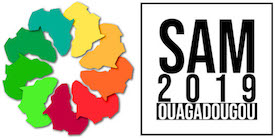At  the session on “Enabling Rural Finance: Multisectoral Collaboration” during last week’s SAM conference, Hedwig Siewertsen of the Africa-based Alliance for a Green Revolution in Africa (AGRA) discussed her work helping the government of Kenya experiment with mechanisms to extend the reach of its limited funding for agriculture. In 2016, the government had USD 7 million to invest in agriculture and was considering acting as a lender to disburse that money to the agricultural sector. Recognizing that the government may be better at market facilitation than managing money, AGRA worked with officials to bring in Barclays Bank of Kenya and the World Bank Group’s International Finance Corporation (IFC) as partners. As a result, the government was able to leverage its USD 7 million to guarantee USD 23 million in lending from Barclays. This enabled 150,000 farmers as well as 300 small and medium-sized enterprises (SMEs) – including producer organizations – to access funding and non-financial assistance, such as help with business planning.
the session on “Enabling Rural Finance: Multisectoral Collaboration” during last week’s SAM conference, Hedwig Siewertsen of the Africa-based Alliance for a Green Revolution in Africa (AGRA) discussed her work helping the government of Kenya experiment with mechanisms to extend the reach of its limited funding for agriculture. In 2016, the government had USD 7 million to invest in agriculture and was considering acting as a lender to disburse that money to the agricultural sector. Recognizing that the government may be better at market facilitation than managing money, AGRA worked with officials to bring in Barclays Bank of Kenya and the World Bank Group’s International Finance Corporation (IFC) as partners. As a result, the government was able to leverage its USD 7 million to guarantee USD 23 million in lending from Barclays. This enabled 150,000 farmers as well as 300 small and medium-sized enterprises (SMEs) – including producer organizations – to access funding and non-financial assistance, such as help with business planning.
At the same session, Ousmane Thiongane of the Senegalese microfinance institution network U-IMCEC, described his organization’s struggles entering the agriculture sector. Despite agriculture being a risky proposition, the organization’s mission demanded that it serve rural areas. At first, he explained, “our rural agents weren’t well trained” in agriculture and thus the entry into rural areas “was a complete failure.” With agents lacking basic information, such as the differing cycles of potato and onion crops, portfolio quality suffered. In response, U-IMCEC began to train loan officers as “local portfolio managers” rather than credit agents. Armed with much improved agricultural knowledge, U-IMCEC was able to give farmers the financial support they need in a way that allowed for institutional stability. This included maintaining a “high-touch” model of staff-client interaction even as the organization brought in more technology. Mr Thiongane says, “We have no choice…microfinance cannot be separated from digitalization today.” While some clients remain uninterested in e-money, financial technology (fintech) is allowing U-IMCEC to reduce its operational costs.
Representing Belgium’s Alterfin, as well as the 12-member Council on Smallholder Agricultural Finance (CSAF), Jean-Marc Debricon discussed the differences between investing in agriculture and mainstream microfinance. For example, loans to producer organizations generally have shorter terms than loans to microfinance institutions. For the members of CSAF, microfinance investments tend to be stronger, allowing them to meet their missions of investing in rural areas where they generally accept more risk or lower returns. Mr Debricon also described CSAF’s work on Aceli Africa, which will launch in 2020 with a pilot program in East Africa. The effort is a public-private partnership mobilizing funds for agricultural SMEs through instruments such as a guarantee fund to protect investors against potential loss.
Safiatou Malet-Coulibaly of Luxembourg-based SOS Faim discussed her NGO’s work with “agri-plus” in Burkina Faso, Mali and Niger. She argued that producers’ organizations are critical partners for managing risk – both market risks and those related to climate change. Ms Malet-Coulibaly’s organization has supported 48 such organizations with loans, guarantees to help them access bank financing, and technical assistance relating to both finance and agriculture.
This article is part of a sponsored series on SAM (the French acronym for African Microfinance Week), a major conference dedicated to financial inclusion in Africa. The most recent SAM took place in Ouagadougou, Burkina Faso, from October 21-25, 2019.
ADA, an NGO based in Luxembourg, co-organizes SAM every two years with the support of Luxembourg’s Ministry for Development Cooperation and Humanitarian Affairs. The SAM steering committee members are: ADA, Luxembourg’s Ministry of Foreign and European Affairs, the Microfinance African Institutions Network, the African Rural and Agricultural Credit Association, and the Fédération des Association Professionnelle des Systèmes Financiers Décentralisés de l’Union Economique et Monétaire Ouest Africaine. We invite you to learn more about SAM at http://www.sam.africa.
MicroCapital has been contracted to promote and document each SAM since 2015.
Additional Resources
Other MicroCapital coverage of SAM and vignettes demonstrating its value to participants
http://www.microcapital.org/category/semaine-africaine-de-la-microfinance-sam/
Vignettes demonstrating the value of SAM en francais
https://www.ada-microfinance.org/fr/evenements/semaine-africaine-microfinance/objectif-sam-2019/paroles-de-nos-participants
Similar Posts:
- MICROCAPITAL BRIEF: AfDB, IFAD Launch M1-200 to Support Agricultural SMEs in Africa
- MICROFINANCE EVENT: Cracking the Nut: Reducing Risk in Rural and Agricultural Investment; June 12-13, 2023; Washington, DC, USA
- MICROCAPITAL BRIEF: AfDB Seeking $1b for African Climate Risk Insurance Facility (ACRIFA) to Boost Microinsurance for Farms, Livestock Against Drought, Floods
- MICROFINANCE EVENT: AFSIC: Investing in Africa; October 9-10, 2023; London, UK
- SPECIAL REPORT: Inclusive Finance in Africa Amid the Current Food and Climate Crises, in Anticipation of SAM 2023 in West Africa
